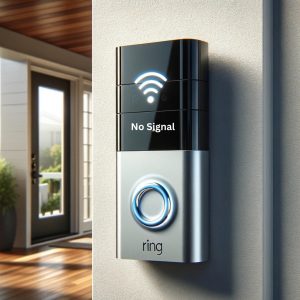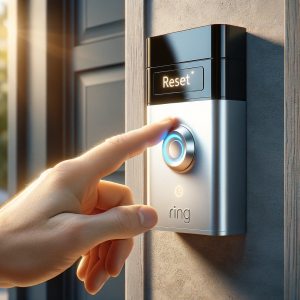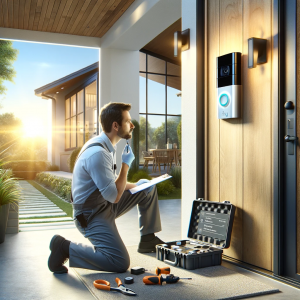Ring Doorbell Not Working
Welcome to our in-depth guide, which is intended to assist you in navigating the typical problems and inquiries relating to your Ring doorbell. Whether you’re encountering issues with your Ring Doorbell not working as expected, or simply seeking advice on how to get the most out of your Ring doorbell, this guide is here to provide you with the answers and solutions you need. With a particular focus on addressing the concern of a Ring doorbell not working we aim to offer step-by-step troubleshooting advice, tips for optimizing your device’s performance, and best practices for maintaining seamless operation. Our goal is to ensure that your Ring doorbell serves as a reliable and effective component of your home security system, keeping you connected and informed at all times. Whether you’re dealing with a specific problem or just looking to enhance your device’s functionality, our guide is tailored to assist you through every step of the process.
Getting Started With Ring Doorbell:
Embarking on your journey with a Ring doorbell marks the beginning of enhanced security and convenience for your home. This section is dedicated to guiding you through the initial steps of setting up your device and ensuring it’s fully operational with optimal Wi-Fi configuration. We’ll also cover how to prepare your device if you’re passing it on to a new owner, ensuring a smooth transition and continued functionality.
-
Initial Setup and Wi-Fi Configuration
Getting your Ring doorbell up and running involves a few crucial steps, with Wi-Fi configuration being a pivotal part of the process. A stable and strong Wi-Fi connection is essential for your Ring doorbell to function correctly, allowing it to send live video feeds, notifications, and updates directly to your smartphone or tablet.
-
-
Powering Your Ring Doorbell:
Start by ensuring your Ring doorbell is charged or connected to power source. A full charge is recommended for battery-operated models to ensure uninterrupted setup.
-
Download the Ring App:
The Ring app acts as the control center for your device. Available on both Android and iOS, the app will guide you through the setup process with step-by-step instructions.
-
Creating or Logging into Your Account:
If you’re new to Ring, you’ll need to create an account. Existing users can simply log in
-
Adding Your Ring Doorbell:
Select “Set Up a Device” in the app and choose “Doorbells.” Follow the on-screen guide to connect your device to your Wi-Fi network.
-
Changing Wifi:
Changing the Wifi network on your Ring doorbell is straightforward. Whether you’re updating your home network or changing Wi-Fi for the Ring doorbell due to connectivity issues, the app provides a seamless way to update your settings without needing to reset the entire device.
-
Access Ring Doorbell Settings:
In the Ring app, select your doorbell and go to “Device Health.”
-
Change Wi-Fi Network:
-
Choose “Change Wi-Fi Network” and follow the prompts to connect to a new network, ensuring your Ring doorbell remains operational and connected.
-
Preparing Your Device for a New Owner
Whether upgrading to a newer model or passing on your device, resetting your Ring doorbell for a new owner is an essential step in ensuring that the new user can set up the device under their account seamlessly.
-
-
Remove the Ring Device from Your Account:
Before physically handing over the device, delete it from your Ring app. Go to “Device Settings,” select “General Settings,” and choose “Remove This Device.” This action disassociates the device from your account, clearing the way for a new registration.
-
Performing a Factory Reset:
To ensure the new owner starts with a fresh slate, performing a factory reset on the Ring doorbell is advisable. If your Ring doorbell is not working, press and hold the setup button on the device for 15 seconds. This step wipes all the previous configurations, making it ready for a new setup process.
-
Inform the New Owner:
Provide the new owner with the device and any relevant accessories or documentation. Let them know that the device has been reset and is ready for them to set up under their own Ring account.
-
By following these steps for initial setup and Wi-Fi configuration, and properly preparing your device for a new owner, you ensure that your Ring doorbell functions flawlessly from the get-go. These processes not only optimize your device’s performance but also safeguard your home security ecosystem, keeping it connected and operational at all times.
Troubleshooting Common Ring Doorbell Not Working Issues:
Navigating through the complexities of modern smart home devices can sometimes be challenging. In this section, we delve into common issues like Ring Doorbell not working, faced by users, offering detailed solutions to ensure your device remains operational and continues to enhance your home’s security.
-
When Your Ring Doorbell Isn’t Working
Experiencing a Ring doorbell not working issue can be frustrating, but several solutions can quickly bring your device back to life. Whether it’s a Ring video doorbell not working scenario or general functionality issues, here’s how to address them:
-
-
Check Ring Doorbell Power Supply:
If your Ring doorbell is not working, ensure that your doorbell is adequately charged or receiving power. A low battery or faulty wiring can often be the culprit behind operational Ring Doorbell problems.
-
Verify Ring Doorbell Wi-Fi Connection:
A stable Wi-Fi connection is crucial. If your doorbell is offline, try reconnecting or improving your Wi-Fi signal strength to resolve Ring doorbell not working issues.
-
Update Ring App and Firmware:
Outdated software can lead to Ring Doorbell not working issues. Ensure your Ring app and doorbell firmware are up to date for optimal functionality.
-
Adjust Motion Settings:
If your doorbell isn’t alerting you to motion, consider adjusting the motion sensitivity settings within the Ring app.
-
Reset Your Ring Doorbell Device:
Sometimes, a simple reset can resolve lingering Ring Doorbell problems. This can range from a soft reset (restarting the device) to a more comprehensive factory reset for more persistent problems.
-
-
Connectivity and Wi-Fi Ring Doorbell Problems:
The functionality of your Ring doorbell can be greatly impacted by connectivity issues, which might range from delayed notifications to issues with video streaming. If you’re facing connectivity and Wi-Fi issues, here’s how to tackle them:
-
-
Check Wi-Fi Signal Strength:
If your Ring Doorbell is not working, use the Ring app to check the Wi-Fi signal strength (RSSI) to your doorbell. If there is a poor signal, think about putting your router closer or using a Wi-Fi extension.
-
Change Wi-Fi Network:
If you’ve recently changed your Wi-Fi network or password, you’ll need to update your Ring doorbell settings. The “change Ring Wi-Fi” process is straightforward via the Ring app under the device health section.
-
Reduce Wi-Fi Interference:
Devices like microwaves & cordless phones can interfere with your Wi-Fi signal causing Ring Doorbell stopped working issue. Try to minimize interference by strategically placing your router or using a different Wi-Fi channel.
-
-
Resetting Your Ring Doorbell
Resetting your Ring doorbell can often resolve unexplained issues or prepare the device for a new owner. Here’s a guide to the different types of resets:
-
-
Soft Reset Ring Doorbell:
A soft reset involves restarting your Ring doorbell without erasing its settings. This can often refresh the device’s connection and resolve minor glitches.
-
Hard Reset Ring Doorbell:
A hard reset Ring Doorbell is slightly more in-depth and can be necessary if the device is unresponsive. You’ll typically press and hold the setup button for a specific period, as outlined in the device’s manual.
-
Ring Doorbell Factory Reset:
Performing a Ring Doorbell factory reset is most comprehensive reset option. This process erases all settings and returns the device to its original state, which is particularly useful when transferring ownership. To execute a factory reset, press & hold the setup button for about 15 seconds or until the device indicates the reset is complete.
-
Troubleshooting common Ring Doorbell problems doesn’t have to be a daunting task. By systematically addressing power, connectivity, and software problems—and knowing how to reset your device when necessary—you can maintain the reliability & functionality of your home security system.
Advanced Troubleshooting For Ring Doorbell Not Working Issues:
Advanced troubleshooting techniques delve into more specific and sometimes intricate issues that may arise with your Ring doorbell. This section aims to provide you with targeted solutions for resolving Ring Doorbell problems and addressing problems specific to the Ring Doorbell Pro model.
-
Dealing with Doorbell Ring Issues
One of the most common concerns for Ring doorbell users is when the Ring doorbell doesn’t ring either externally at the door or internally through the home chime or connected devices. Here are steps to troubleshoot and resolve Ring Doorbell problems:
-
-
Check Volume and Chime Settings:
If your ring doorbell won’t ring. First, ensure that the volume on your Ring app is turned up and that the chime settings are correctly configured. It’s possible that these settings were inadvertently adjusted.

-
Inspect the Wi-Fi Connection:
A poor Wi-Fi connection can affect the doorbell’s ability to send a signal to the internal chime or your mobile device. If your ring doorbell won’t ring, verify the Wi-Fi signal strength & make any necessary adjustments to improve connectivity.
-
Verify Device Health:
Use the Ring app to check the device’s health. This feature can help identify if there are any reported issues with your doorbell that could be affecting its performance, including the internal ringing mechanism.
-
Test the Internal Chime:
If you have a wired Ring doorbell connected to an internal chime, ensure that the chime is operational and that there are no wiring issues. Sometimes, a simple wiring fix can resolve the problem.
-
Reconnect or Reset Your Device:
If the above steps don’t resolve the issue, try reconnecting your Ring doorbell to the app or performing a reset. For persistent problems, a “factory reset” may be necessary to clear any glitches causing the doorbell not to ring.
-
-
Specific Device Troubleshooting: Ring Doorbell Pro:
The Ring Doorbell Pro is a popular model that offers advanced features. However, like any sophisticated device, it may encounter specific Ring Doorbell problems requiring focused troubleshooting:
-
-
Power Issues:
If your Ring Doorbell is not working, ensure that your Ring Doorbell Pro is receiving adequate power. Unlike battery-operated models, the Pro version requires a stable electrical connection. Insufficient power can lead to operational issues.
-
Wi-Fi Connectivity:
The Ring Doorbell Pro requires a strong and stable Wi-Fi connection for optimal performance. Use the Ring app to assess the Wi-Fi signal strength and consider using a Wi-Fi extender if necessary.
-
Firmware Updates:
Regularly check for and install firmware updates for your Ring Doorbell Pro. Outdated firmware can lead to Ring Doorbell problems, including connectivity and ringing problems.
-
Performing a Reset:
If you’re experiencing unresolvable Ring Doorbell problems a “reset” may be necessary. To reset Ring Doorbell Pro,” press and hold the side button for approximately 15 seconds. This action will initiate a factory reset, clearing any software issues and allowing you to set up the device anew.
-
By systematically addressing Ring Doorbell problems and specific concerns related to the Ring Doorbell Pro, you can make sure that your device operates efficiently and continues to provide the security and convenience expected from a Ring product. Advanced troubleshooting can often resolve seemingly complex problems, restoring full functionality to your doorbell.
FAQs:
Q1. Why is my Ring doorbell not working, and how can I fix it?
- A. If your Ring doorbell is not working, start by checking the device’s power supply (battery charge for wireless models or wiring for wired models) and ensuring your Wi-Fi connection is stable. A soft reset by restarting the device or a factory reset for more severe issues may also resolve the problem.
Q2. How to Reset Ring doorbell when it stops functioning properly?
- A. To reset your Ring doorbell, press and hold the setup button on the back of the device for about 15 seconds. This action will initiate a factory reset, erasing all settings and allowing you to set up the device as new.
Q3. What steps should I take if my Ring doorbell is not working or alerting my phone?
- A. Ensure your notification settings are correctly configured in the Ring app and that the device is online with a strong Wi-Fi signal. Checking the device’s health via the app can also identify any signal or power issues that may affect performance.
Q4. How can I change the Wi-Fi network on my Ring doorbell?
- A. To “change the Wi-Fi network on your Ring doorbell,” open the Ring app, select your device, go to Device Health, and choose “Change Wi-Fi Network.” Follow prompts to connect your doorbell to a new Wi-Fi network.
Q5. Why does my Ring doorbell not detect motion, and how can I improve motion detection?
- A. If your Ring doorbell is not detecting motion, adjust the motion sensitivity settings in the Ring app. Experiment with different motion zones and sensitivity levels to find the best setup for your specific location.
Conclusion:
Throughout this comprehensive guide, we’ve explored a variety of solutions and strategies aimed at addressing common and advanced issues that might arise with your Ring doorbell. From the initial setup and Wi-Fi configuration to troubleshooting common problems like when your “Ring doorbell is not working,” we’ve covered the essential steps to ensure your device functions optimally. We delved into advanced troubleshooting for specific models such as the Ring Doorbell Pro and provided insights on maximizing device performance and enhancing Wi-Fi connectivity
The key points we’ve emphasized include the importance of maintaining a stable Wi-Fi connection, the benefits of regular device maintenance and firmware updates, and the critical steps for resetting your device in various scenarios. Additionally, we’ve offered tips on optimizing your Ring doorbell’s settings to enhance its performance and your overall experience.
We hope this guide has been helpful in addressing your concerns and improving your Ring doorbell’s functionality. Your feedback is invaluable to us, and we encourage you to share your experiences, additional topics of interest, or any questions you may have. This dialogue helps us to continually improve and expand our resources, ensuring they remain relevant and beneficial to your needs. Whether your “Ring doorbell is not working” or you’re simply looking to optimize your device’s setup, we’re here to support and guide you through every step of the process, ensuring your home remains secure and connected.
To know more about Ring Doorbell and resolve its related issues, visit Ring Support page.

Christopher Sanchez
Despite following the initial setup instructions, my Ring doorbell is not working, and it’s not charging or holding a charge as expected. Could you provide a detailed walk through on troubleshooting this issue, emphasizing power supply checks and battery maintenance?
Support Admin
If your Ring doorbell is not working or not holding a charge, start by checking the power source to ensure it’s properly connected and operational. For battery-operated models, ensure the battery is fully inserted and correctly seated. If your Ring doorbell is hardwired, verify the wiring connections for security and consistent power.
Next, assess the battery’s condition via the Ring app by navigating to “Device Health.” A battery that’s nearing the end of its life may not hold a charge well and could need replacing. Additionally, extreme temperatures can adversely affect battery performance.
If your Ring doorbell continues to have issues, consider changing the WiFi for the Ring doorbell if network problems are suspected, or factory reset the Ring doorbell for more severe issues. To factory reset your Ring video doorbell, follow the instructions in the Ring doorbell troubleshooting section of your user manual. This is also a helpful step if you’re experiencing problems with the Ring door chime not working.
For connectivity issues, changing WiFi on your Ring doorbell might resolve the problem. If you need to reset your Ring camera or Ring chime, these steps can also apply. Remember, a factory reset should be your last resort as it will remove all your custom settings.
Carol miller
I’ve noticed delays in video streaming and receiving notifications from my Ring doorbell, suggesting a Wi-Fi connectivity issue. Could you detail the steps to enhance the Wi-Fi connection strength and reduce interference, as mentioned in the Wi-Fi configuration and troubleshooting sections?
Support Admin
Improving your Ring doorbell’s Wi-Fi connection involves several key steps. First, assess the Wi-Fi signal strength (RSSI) to your doorbell using the Ring app’s “Device Health” feature. A weak signal may require repositioning your router closer to the doorbell or using a Wi-Fi extender.
Reduce Wi-Fi interference by ensuring your router is away from large metal objects, microwaves, and cordless phone bases. Consider changing your Wi-Fi channel to one with less interference, which can be done through your router’s settings.
If connectivity issues persist, try changing the Wi-Fi network your Ring doorbell is connected to, as described in the guide. This can be done via the “Change Wi-Fi Network” option in the Ring app under “Device Health.” Lastly, ensure your router’s firmware is up to date to support optimal performance and compatibility with your Ring doorbell.
Emily johnson
I’ve encountered issues with my Ring doorbell not detecting motion consistently, leading to missed alerts. Could you explain how to optimize the motion detection settings, including adjusting motion zones and sensitivity, to improve reliability as mentioned in the motion settings adjustment advice?
Support Admin
Optimizing your Ring doorbell’s motion detection settings involves fine-tuning the motion zones and sensitivity to suit your home’s layout and your security needs. Start by accessing the motion settings in the Ring app, where you can customize the motion zones to focus on specific areas you want to monitor while excluding zones with frequent non-alert activity.
Adjust the motion sensitivity slider to find a balance that minimizes false alarms while ensuring you’re alerted to actual events. If your device supports it, utilize advanced motion detection features like People Only Mode to further refine the alerts you receive.
Regularly review and adjust these settings based on your observations and any changes in the environment around your home, such as new construction or changes in landscaping, to maintain optimal motion detection performance.